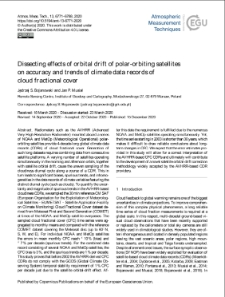Biblioteka Cyfrowa Instytutu Geodezji i Kartografii udostępnia 1 099 obiektów cyfrowych
Obiekt
Tytuł: Dissecting effects of orbital drift of polar-orbiting satellites on accuracy and trends of climate data records of cloud fractional cover
Abstrakt:
Wydawca:
Data wydania:
Format:
Identyfikator zasobu:
DOI:
Język:
Powiązanie:
Atmospheric Measurement Techniques
Numer Zeszytu:
Prawa dostępu:
Dla wszystkich w zakresie dozwolonego użytku
Licencja:
Kolekcje, do których przypisany jest obiekt:
Data ostatniej modyfikacji:
21 gru 2020
Data dodania obiektu:
21 gru 2020
Liczba wyświetleń treści obiektu:
155
Liczba wyświetleń treści obiektu w formacie PDF
182
Wszystkie dostępne wersje tego obiektu:
http://bc.igik.edu.pl/publication/1128
Wyświetl opis w formacie RDF:
Wyświetl opis w formacie OAI-PMH:
Obiekty Podobne
Jędrzej Bojanowski Jan Musiał
Bojanowski, Jędrzej Musiał, Jan
Musiał, Jan Bojanowski, Jędrzej
Bojanowski, Jędrzej Stöckli, Reto
Kulesza, Kinga Bojanowski, Jędrzej S.
Musiał, Jan
Bojanowski, Jędrzej Stöckli, Reto Duguay-Tetzlaff, Anke Finkensieper, Stephan Hollmann, Rainer
Musiał, Jan Dąbrowska-Zielińska, Katarzyna Kiryła, Wojciech Oleszczuk, Ryszard Gnatowski, Tomasz Jaszczyński, Jacek


